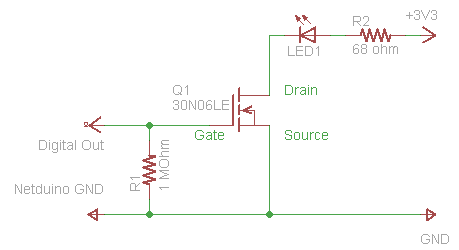
Short Circuit Protection With A MOSFET

In applications where a MOSFET is employed to switch a load, incorporating short-circuit or overload protection is straightforward. This can be achieved by utilizing the internal resistance RDS(ON) of the MOSFET, which generates a voltage drop proportional to the current flowing through it. This voltage across the internal resistance can be monitored using a simple comparator or a transistor that activates at approximately 0.5V. This method eliminates the need for a sense resistor (shunt), which typically introduces an undesirable additional voltage drop. The comparator can be interfaced with a microcontroller, allowing for software-based responses to overload conditions, such as PWM regulation, alarms, or emergency stops. Additionally, the comparator output can be connected directly to the gate of the MOSFET to immediately disable the transistor in the event of a short circuit.
In the described circuit, the MOSFET operates as a switch for the load, with its internal resistance RDS(ON) serving as a means to detect current levels. The voltage drop across RDS(ON) is directly proportional to the current flowing through the MOSFET, allowing for effective monitoring of the load conditions. The comparator is set to trigger at a threshold voltage of around 0.5V, which corresponds to a specific current limit that indicates an overload condition.
When the voltage across RDS(ON) exceeds this threshold, the comparator activates, signaling the microcontroller to implement protective measures. These measures can include adjusting the PWM signal driving the MOSFET to reduce the load current, activating an alarm to alert users, or initiating an emergency stop to disconnect the load entirely. This layered approach to overload protection enhances system reliability and safety.
Furthermore, connecting the comparator output directly to the MOSFET gate allows for immediate response to short-circuit events. When a short circuit occurs, the rapid increase in current causes the voltage across RDS(ON) to rise quickly, triggering the comparator. This action results in the MOSFET being turned off almost instantaneously, thereby protecting the circuit from potential damage.
Overall, this design leverages the inherent properties of the MOSFET and simple components to create an efficient and effective overload and short-circuit protection mechanism, enhancing the robustness of electronic applications that rely on MOSFET switching.If you have an application in which a MOSFET is already used to switch a load, it is relatively easy to add short-circuit or overload protection. Here we make use of the internal resistance RDS(ON), which produces a voltage drop that depends on the amount of current flowing through the MOSFET.
The voltage across the internal resistance can be sensed using simple comparator or even a transistor, which switches on at a voltage of around 0. 5V. You can thus avoid the use of a sense resistor (shunt), which usually produces an undesirable extra voltage drop. The comparator can be monitored by a microcontroller. In case of an overload, the software can initiate suitable countermeasures (PWM regulation, alarm, emergency stop etc.
). It is also conceivable to connect the comparator output directly to the gate of the MOSFET, in order to immediately cut off the transistor in case of a short circuit. 🔗 External reference
In the described circuit, the MOSFET operates as a switch for the load, with its internal resistance RDS(ON) serving as a means to detect current levels. The voltage drop across RDS(ON) is directly proportional to the current flowing through the MOSFET, allowing for effective monitoring of the load conditions. The comparator is set to trigger at a threshold voltage of around 0.5V, which corresponds to a specific current limit that indicates an overload condition.
When the voltage across RDS(ON) exceeds this threshold, the comparator activates, signaling the microcontroller to implement protective measures. These measures can include adjusting the PWM signal driving the MOSFET to reduce the load current, activating an alarm to alert users, or initiating an emergency stop to disconnect the load entirely. This layered approach to overload protection enhances system reliability and safety.
Furthermore, connecting the comparator output directly to the MOSFET gate allows for immediate response to short-circuit events. When a short circuit occurs, the rapid increase in current causes the voltage across RDS(ON) to rise quickly, triggering the comparator. This action results in the MOSFET being turned off almost instantaneously, thereby protecting the circuit from potential damage.
Overall, this design leverages the inherent properties of the MOSFET and simple components to create an efficient and effective overload and short-circuit protection mechanism, enhancing the robustness of electronic applications that rely on MOSFET switching.If you have an application in which a MOSFET is already used to switch a load, it is relatively easy to add short-circuit or overload protection. Here we make use of the internal resistance RDS(ON), which produces a voltage drop that depends on the amount of current flowing through the MOSFET.
The voltage across the internal resistance can be sensed using simple comparator or even a transistor, which switches on at a voltage of around 0. 5V. You can thus avoid the use of a sense resistor (shunt), which usually produces an undesirable extra voltage drop. The comparator can be monitored by a microcontroller. In case of an overload, the software can initiate suitable countermeasures (PWM regulation, alarm, emergency stop etc.
). It is also conceivable to connect the comparator output directly to the gate of the MOSFET, in order to immediately cut off the transistor in case of a short circuit. 🔗 External reference





